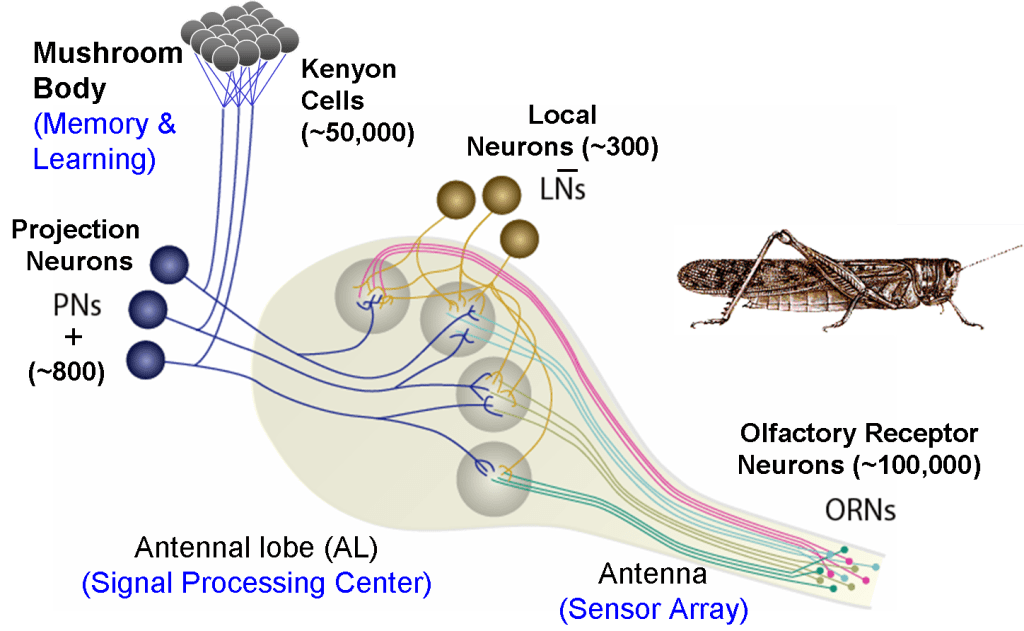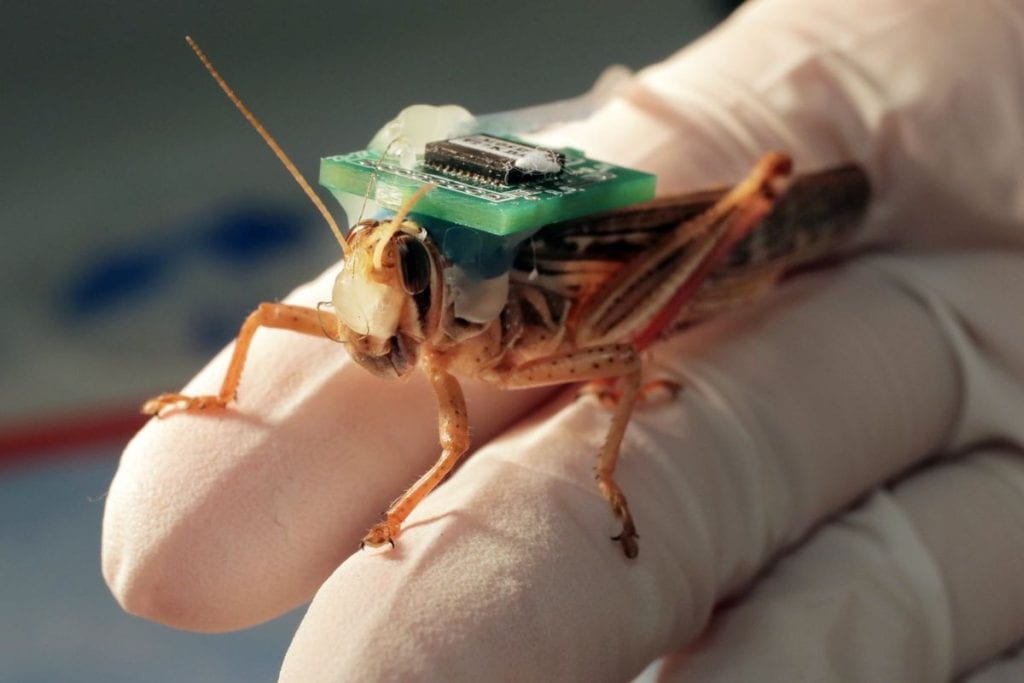My lab is interested in understanding the design and computing principles of biological sensory systems and translating this knowledge into bio-inspired intelligent systems and machine learning algorithms. Research in my lab involves two main themes:
- Systems Neuroscience: an investigation that will combine computational and electrophysiological approaches to examine fundamental principles of olfactory coding and signal processing, learning, and memory
- Neuromorphic Engineering: development of novel, bio-inspired devices (e.g. ‘electronic nose’) and algorithmic tools for non-invasive medical diagnosis and homeland security applications
Biological Olfaction

How does the nervous system convert sensory stimuli into neural representations? Odorants are detected by a large population of olfactory receptor neurons (ORNs), which convert chemical stimuli into an electrical signal that is relayed downstream for further processing in the olfactory bulb (OB, vertebrates) or the antennal lobe (AL, insects). In the AL/OB, interactions between ensembles of excitatory principal neurons and inhibitory local neurons reshape the ORN input into complex, slow spatio-temporal patterns that are superimposed on a faster oscillatory field potential activity. The patterned AL/OB responses contain information about odor identity and intensity and form the only odor representation available to the organism. Hence they are considered to be the ‘odor code’. The generated odor code is then transmitted to learning and memory centers.
Related Publications:
- Neural manifolds for odor-driven innate and acquired appetitive preferences
R. Chandak, B. Raman†
Nature Communications, volume 14, Article number: 4719 (2023) - Invariant Odor Recognition with ON-OFF Neural Ensembles
S. Nizampatnam, L. Zhang, R. Chandak, J. Li, B. Raman†
Proceedings of the National Academy of Sciences, January 11, 2022 119 (2) e2023340118 - Dynamic contrast enhancement and flexible odor codes
S. Nizampatnam*, D. Saha*, R. Chandak* and B. Raman†
Nature Communications 9, article number: 3062, August 2018. - Engaging and disengaging recurrent inhibition coincides with sensing and unsensing of a sensory stimulus
D. Saha*, W. Sun*, C. Li*, S. Nizampatnam, W. Padovano, Z. Chen, A. Chen, E. Altan, R. Lo, D. L. Barbour, and B. Raman†
Nature Communications 8, article number: 15413, May 2017. - A spatiotemporal coding mechanism for background-invariant odor recognition
D. Saha*, K. Leong*, C. Li*, G. Siegel and B. Raman†
Nature Neuroscience, vol. 16, pp. 1830-1839, 2013.
Artificial Olfaction


An electronic nose is an instrument that combines an array of cross-selective chemical sensors and a pattern recognition engine to recognize chemical species. We employ statistical and bio-inspired signal approaches to design & operate MEMS-based chemiresistive microsensor arrays and tune them for specific chemical sensing application
Target applications for electronic nose include:
- Medical Diagnostics (Breath Analysis)
- Homeland Security
Related Publications:
- In Situ Grown Gold Nanoisland-Based Chemiresistive Electronic Nose for Sniffing Distinct Odor Fingerprints
P. Gupta, H. G. Derami, D. Mehta, H. Yilmaz, S. Chakrabartty, B. Raman†, and S. Singamaneni†
ACS Applied Materials & Interfaces Article ASAP, DOI: 10.1021/acsami.1c22173 - Gold-Nanorod-Based Plasmonic Nose for Analysis of Chemical Mixtures
H. Yilmaz, S. H. Bae, S. Cao, Z. Wang, B. Raman†, S. Singamaneni
ACS Applied Nano Materials, Vol. 2, No. 2, pp: 3897-3905, May 2019. - Breathprinting reveals malaria-associated biomarkers and mosquito attractants
Chad L Schaber, Nalin Katta, Lucy B Bollinger, Mwawi Mwale, Rachel Mlotha-Mitole, Indi Trehan, Barani Raman, Audrey R Odom John
The Journal of infectious diseases 217(1553-1560), 2018. - Designing and Optimizing Microsensor Arrays for Recognizing Chemical Hazards in Complex Environments
B. Raman, D. C. Meier, J. K. Evju and S. Semancik
Sensors and Actuators B, Vol. 137(2), pp. 617-629, April 2009
Insect-based brain machine interface for bio-hybrid Olfaction

Insect-based biorobots
The ability of biological olfaction far outshines the capabilities attained by artificial analogues. The canine olfactory system still remains the state-of-art sensing system for many engineering applications, including, homeland security and medical diagnosis.
Given that even simple biological organisms possess superior sensing capabilities than the state-of-art engineering technologies, could the capabilities of biological organisms be exploited for the purpose of creating a novel class of bio-hybrid sensing systems? Recent work has shown that insects have chemical sensors for a range of applications including explosive chemical species, cancer, and other biomarkers. While these efforts provide proof-of-concept results further validation of biological system’s capabilities, and whether and how robust insect-machine interfaces can be made for the purpose of remote-controlled sensing remain open problems.
Related Publications:
- Augmenting insect olfaction performance through nano-neuromodulation
P. Gupta, R. Chandak, A. Debnath, M. Traner, B. M. Watson, H. Huang, H. G. Derami, H. Baldi, S. Chakrabartty, B. Raman†, S. Singamaneni†
Nature Nanotechnology 2024; https://doi.org/10.1038/s41565-023-01592-z - Explosive sensing with insect-based biorobots
Debajit Saha, Darshit Mehta, Ege Altan, Rishabh Chandak, Mike Traner, Ray Lo, Prashant Gupta, Srikanth Singamaneni, Shantanu Chakrabartty, Baranidharan Raman†
Biosensors and Bioelectronics: X, vol. 6, 1 December 2020, 100050 - Remote-controlled insect navigation using plasmonic nanotattoos
Sirimuvva Tadepalli, Sisi Cao, Debajit Saha, Keng-Ku Liu, Alex Chen, Sang Hyun Bae, Baranidharan Raman, Srikanth Singamaneni
bioRxiv 2020.02.10.942540, 2020. doi: https://doi.org/10.1101/2020.02.10.942540. - Behaving Cyborg Locusts for Standoff Chemical Sensing
D. Mehta, E. Altan, R. Chandak, B. Raman, S. Chakrabartty,
IEEE International Symposium on Circuits and Systems, 2017.